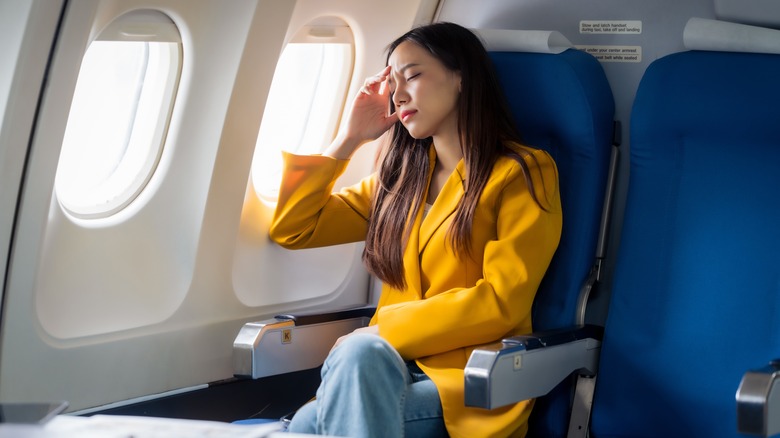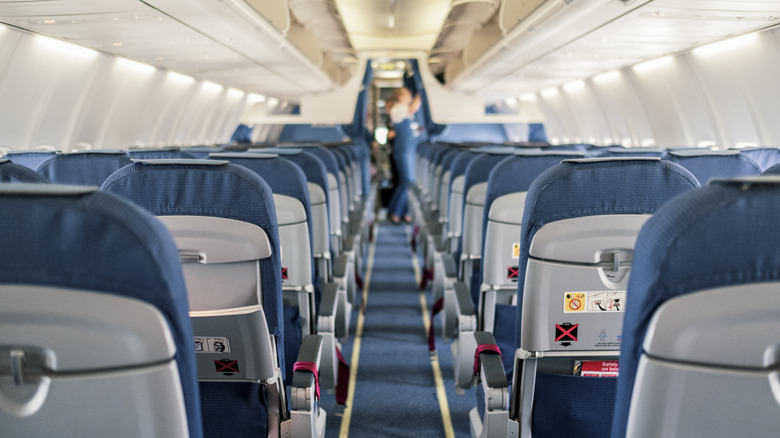Sit In This Spot If You're Worried About Getting Motion Sickness During Your Flight
Though airplane travel is the most efficient way to get to your dream destination, it may not be the natural favorite for anyone prone to motion sickness at 30,000 feet, especially during bouts of turbulence. The good news is, not all seats are created equal. In fact, there's one zone where you're less likely to experience a bumpy ride: the front of the economy section — roughly seats 10 to 30 on popular aircrafts like a Boeing 737.
For all those first-class lovers out there, there's a scientific reason why economy fliers fare a bit better in this case. Dr. Quay Snyder, the president of the Aviation Medicine Advisory Service told Condé Nast Traveler that these are the rows fixed above the wings of an aircraft, which is well-known as the most stable part of the plane.
A commercial pilot named Jonny Knowlson (a.k.a. "Jonny the Pilot," if you follow him on social media) seconds this notion in an interview with the Daily Mail. He has found that sitting above the wings means that you're less likely to feel the full effects of the natural movements of an airplane, like the lift up, thrust forward, torque, gravity, and drag. Your stomach will be pleased.
How to pick the best seat in the house
For the friendliest skies, book an early morning departure, as you're less likely to face turbulence, explained former Qantas pilot Trevor Aldous to Delicious. Also, book with an airline where you can pick your seat. Simply pull up the seating chart and find the wings, then choose accordingly. The ideal zone will change depending on the aircraft. While rows 12 to 25 are located above the wings on a Boeing 737, the sweet spot shifts to rows 28 through 41 on a Boeing 747. From there, a window seat is best so you can keep your eyes on the horizon. After all, motion sickness is caused by conflicting information between your eyes and inner ears, so looking out the window can help settle your senses.
For passengers on a budget, an airline like Southwest with an open seating policy might make the most sense. In that case, notify a flight attendant that you're prone to motion sickness. They may be able to reseat you without much hassle. If your budget is less of an issue, the front of the plane (i.e., first class) is also a stable area, with plenty of amenities to distract you from feeling ill. The only time you might experience a little chop is during a rough landing — but hey, at least you're on the ground, right? Whatever you decide, just avoid sitting at the tail end. Those are the worst rows of the plane for sensitive fliers, as the bouncing is more intense.
Tips for reducing symptoms of motion sickness
Sometimes, no matter which seat you book, nausea can still rear its ugly head. And unlike seasickness on a cruise, you can't disembark or open a window for some fresh air. If you're part of the one in three people who get motion sickness while traveling, per the National Library of Medicine, take a few extra steps to assuage your symptoms.
First, skip the books and movies, as they may make you feel worse. Instead, fix your gaze on the horizon outside the window or shut your eyes and listen to an audiobook or calming music on your headphones. Anxiety exacerbates motion sickness, so dig into some self-soothing techniques. Some cool air from the vent can feel refreshing, as can meditation or deep breathing. A 2020 randomized control trial published in Complementary Therapies in Clinical Practice found that hospital patients who did breathing exercises reported less nausea than the control group. If you can score a whole row to yourself, lay down and try to get some sleep.
Certain teas can help, too. Ask a flight attendant for peppermint tea or bring some in your carry-on, as a 2021 study in the Journal of Holistic Nursing suggests the scent of peppermint can calm an upset stomach. Researchers have reached similar conclusions about ginger-infused products, as noted in a 2019 meta-analysis in the journal Food Science & Nutrition. Most importantly, stay hydrated with small sips and remind yourself that this is temporary. You'll be back on the ground soon.


